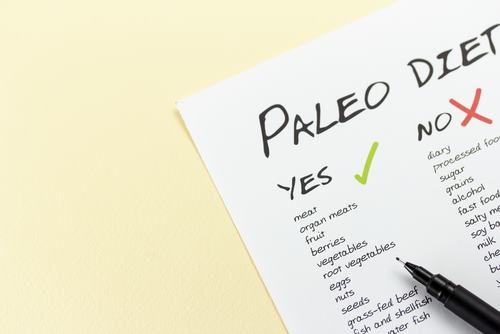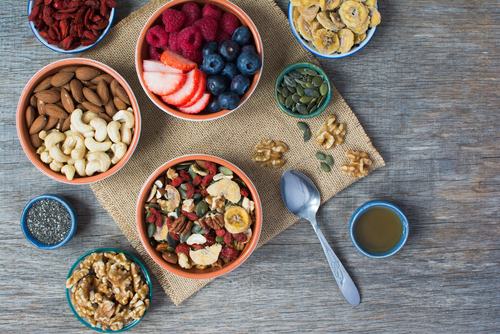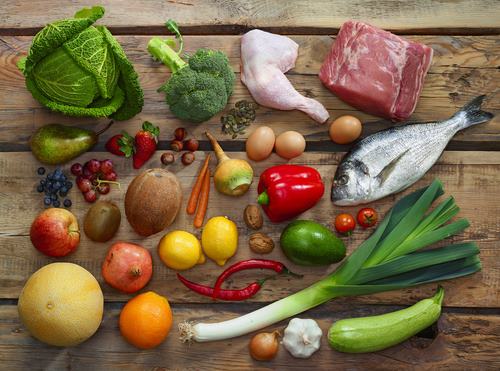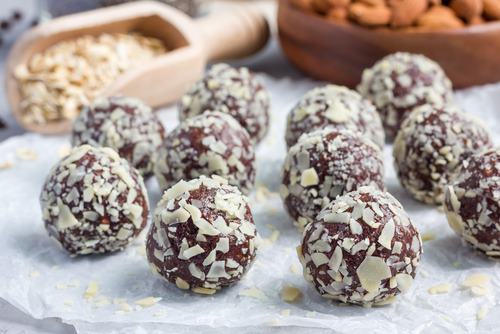The Ultimate Paleo Diet Food List
THIS POST MAY CONTAIN AFFILIATE LINKS. PLEASE SEE OUR FULL DISCLOSURE POLICY FOR DETAILS.
The Paleo diet is hot right now – and for good reasons. What you might not know is that the idea of eating like a paleolithic-era human got its start back in the 1890s, when Dr. Emmet Desnmore called bread the “staff of death” rather than the more-common staff of life.

Fast forward to 2002, when Loren Cordain’s popular book The Paleo Diet was introduced. In a nutshell, the diet recommends foods that were probably available to humans during the Paleolithic era; however items with similar characteristics make their way onto the Paleo food list.
If you’re following Paleo, then grab the Clutter Keeper Meal Planner to keep yourself organized. You can track your favorite recipes and write out your grocery lists, and more!
What are the benefits of the Paleo Diet?
The Paleo diet offers a number of benefits, with the best being that it is a clean, whole-foods based way of eating that eliminates problematic substances like processed sugar, high-salt food, and processed foods that contain harmful trans fats and chemical additives.
So long as you consume a wide variety of plant-based foods rather than relying solely on meats, you’ll enjoy plenty of vitamins, minerals, and micronutrients each day. The focus on lean meats and seafoods over high-fat and processed varieties means that you’ll take in less cholesterol than the average person who eats fatty meats and dairy products. Plus, stopping dairy and grains means eliminating two major food groups linked to intolerances that can exacerbate inflammatory diseases. If you are interested in Check out Cholesterol Lowering Foods List, we have also gathered nice tips for you.
Many people switch to the Paleo diet in hopes of losing weight – and many do meet that goal. More benefits of the Paleo diet include:
- Little to no chemical intake from food
- Lower risk of diabetes
- Steady, even energy; no more sugar crashes or hunger pangs
- Plenty of good foods to choose from; simple choices make life easier
- No calorie counting required
- Can be budget-friendly, particularly if you cut out fast food and most restaurant meals
Sample Shopping List
While you’ll find plenty of options here, this paleo diet grocery list is by no means exhaustive. It does contain the top 10 paleo diet foods you absolutely need to be eating on a regular basis; these are marked with asterisks. This list is broken down by meal for easy referencing. You’ll notice that specific amounts are omitted; get the amount you think you’ll need to feed your family, enjoy leftovers for lunch, or prepare and freeze for later use.
You might find it very helpful to review some Paleo recipes before venturing out on your first shopping trip. True, you can eat these foods in their whole, unaltered form, but recipes can serve as inspiration and give you plenty of ideas for creating delicious meals that won’t leave you feeling bored and tipping toward a return to the standard American diet (SAD).
Paleo diet food list: Breakfast

- Eggs, preferably free-range
- Nuts
- Seeds such as flax, pumpkin, and chia
- Paleo granola
- Paleo pancake mix
- Paleo smoothie mix
- Coconut yogurt
- Dried fruit
- Fresh fruit
- Berries such as blueberries*, strawberries, and raspberries
- No-sugar added nut milk, i.e. almond, coconut, or cashew
Paleo diet food list: Lunch

- Salad ingredients such as lettuce, spinach*, cabbage, tomatoes*, and kale
- Fresh vegetables
- Lean protein – salmon*, chicken breast, trout, etc.
- Paleo-friendly soups
- Nuts
- Seeds
- Berries
- Fresh fruit, especially citrus* – ideal for adding to salad for optimal iron absorption
- Dried fruit
Paleo diet food list: Dinner

- Lean protein – chicken breast, lean beef steaks, bison burger, venison, etc.
- Favorite vegetables – Mushrooms, asparagus, broccoli, cauliflower, green beans, etc.
- Salad ingredients like lettuce, spinach, avocado*, etc.
- Fresh fruits
- Berries and dark chocolate* (as close to 100% cacao as possible) for dessert a few times per week
Paleo diet food list: Snacks

- Fruits, fresh or dried
- Berries
- Fresh vegetables
- Nuts
- Nut butters such as cashew or almond (be sure there’s no sugar added)
- Paleo-friendly snack bars such as Larabars
Paleo diet food list: Seasonings and Beverages
- Favorite herbs, i.e. basil, garlic, thyme, oregano, pepper, cayenne pepper, paprika, etc.
- Extra-virgin olive oil*
- Green tea*
- Sulfate-free wine*
Overview
As illustrated by the paleo diet food list for beginners above, there are several categories from which to choose when crafting a meal plan. As with any healthy diet, it’s best to enjoy plenty of variety in your day-to-day intake, and to ensure that you are eating plenty of colorful vegetables and fruits. It’s assumed that Paleolithic people ate a wide array of foods from these categories depending on what was available – and while there’s a misconception that “cave men” ate mostly meat, Paleo people had meat only when they enjoyed a successful hunt. Most of their foods were plant-based, meaning nuts, seeds, vegetables, and fruits. Eggs could be foraged for, and so could insects – although you won’t find crickets, grasshoppers, and other creepy-crawlies on this Paleo food list.
Beverages, with a strong preference for water and herbal teas
- beer (no more than one 12-ounce serving per day, preferably occasional use only)
- coffee, preferably black or with a no-sugar added nut milk
- diet sodas made with stevia, xylitol, or monk fruit rather than potentially toxic artificial sweeteners
- mineral water
- sparkling water with or without added natural flavor
- tea
- wine (no more than two 4-ounce glasses per day, preferably occasional use only)
Lean meats, preferably organic, grass-fed, wild, and/or free-range:
- beef (leanest cuts only; avoid any with marbling)
- buffalo / bison
- caribou
- chicken breast
- elk
- partridge
- game hens
- grouse
- moose
- ostrich
- pheasant
- pork (leanest cuts only)
- quail
- rabbit
- venison
- wild duck
- wild goose
- wild pig / javelina
- wild turkey
Fish, shellfish, and other seafood, preferably wild-sourced, low-mercury species:
- bass
- clams
- cod
- drum
- eel
- grouper
- haddock
- halibut
- herring
- mackerel
- northern pike
- oysters
- perch
- salmon
- scallops
- scrod
- shrimp (try to avoid farmed shrimp as many are fed a poor-quality diet)
- trout
- turbot
- walleye
Eggs, preferably the organic, free-range variety, up to six per week:
- Chicken
- Duck
- Goose
- Quail
- Turkey
Colorful, non-starchy fruits and vegetables:
- apples
- apricots
- artichokes
- asparagus
- avocados
- berries, i.e. blackberries, blueberries, raspberries, strawberries, etc.
- broccoli
- cauliflower
- cherries
- citrus fruits, i.e. lemons, oranges, tangerines, etc.
- figs
- grapes
- green beans
- kale
- lettuce
- melons, i.e. cantaloupe, watermelon, cassava melon, etc.
- nectarines
- peaches
- pears
- peppers
- spinach
- tomatoes
- Nuts and seeds, with the exception of peanuts, which are legumes
- Plant-based oils, i.e. avocado, olive, coconut, grapeseed, etc.
Paleo Diet Food List: Not Allowed
Take a look at just about any Paleo diet food list pdf and you’ll find specific items to eat and avoid. These lists can help you find answers to common questions such as “Can you eat rice on Paleo?” (That’s a “no,” unfortunately). Here’s a quick list of foods to avoid on Paleo. Note that certain items like bread, tortillas, and muffins can be made with paleo-friendly ingredients. It’s the common, grain-containing bakery items that you’ll want to avoid when following the Paleo diet. This list helps us to have a clean eating that will help us to be healthy and have some weight loss.
- Dairy products and foods that contain them:
- butter
- dairy spreads such as those containing yogurt
- cheese (all types)
- milk (all types)
- cream
- half-and-half
- ice cream
- yogurt and frozen yogurt
- Legumes and items that contain them:
- beans of all types
- black-eyed peas
- lentils
- miso
- peanuts
- peanut butter
- peas, including sugar snap and snowpea varieties
- soybeans and soy products
- tofu
- TVP
- Grains, grain-like seeds, and items that contain them:
- amaranth
- barley
- buckwheat
- bread
- cakes
- corn
- millet
- muffins
- oats
- pancakes
- pasta
- pizza crust
- pretzels
- rice
- rye
- quinoa
- sorghum
- tortillas
- tortilla chips
- waffles
- wheat
- wild rice
- High-fat meats
- Bacon
- Chicken legs, skin, and thighs
- Fatty cuts of beef, lamb, pork, etc.
- Ribs (beef & pork)
- Sausages (lean, fresh varieties may be OK if low-sodium)
- Turkey legs, skin, and thighs
- High-sodium foods:
- Bacon
- Canned, smoked, and dried fish and meats (some can be soaked and drained to reduce sodium)
- Deli-style meats
- Ham
- Hot dogs
- Most condiments, salad dressings, etc.
- Olives
- Salted nuts
- Sausages
- Spices containing salt
- Starchy vegetables and foods that contain them:
- Cassava
- French fries
- Manioc
- Potatoes
- Potato chips
- Sweet potatoes and yams (these are often considered OK in moderation, particularly if you’re not trying to lose weight)
- Tapioca
- Sugary foods and beverages:
- Cakes
- Candies
- Cupcakes
- Desserts made with sugar
- Donuts
- Honey
- Sodas
- Sports drinks
- Sugars of all kinds: White, demerara, powdered, brown, turbinado, etc.
Quick Tip:
No matter what language you speak, it’s possible to learn which foods to eat and avoid; the Paleo diet is popular all over the world. Here’s a quick video guide in Spanish. Books, recipes, and other resources are available to everyone, making the Paleo diet accessible as well as sensible.

